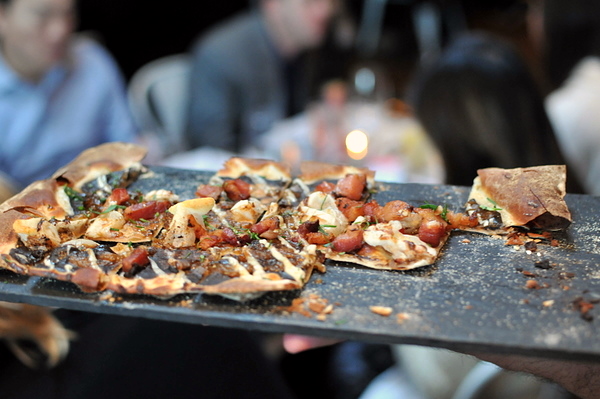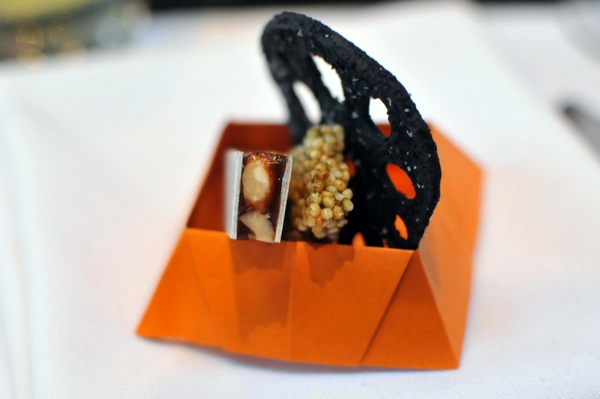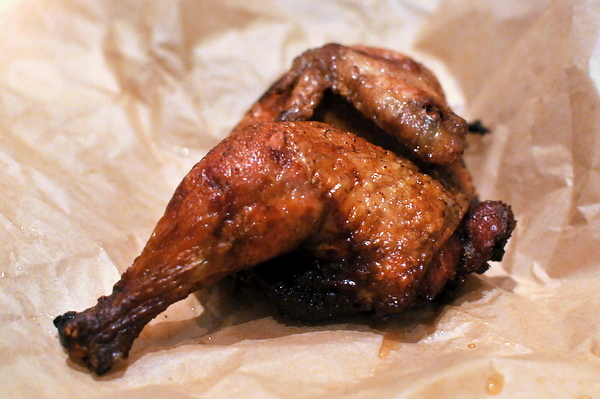Denver, CO 80202
(303) 996-9985
Though Roy's Hawaiian "Fusion" (shudder) has its share of ardent fans, I am not one of them. So when I saw one of Roy's protegees had opened a restaurant serving "continental social food" I was pretty skeptical. Already dubious, when I saw the "Omakase" option on the menu I almost dismissed TAG out of hand, thinking they were just trying to play off use the term to build mystique. When I called the restaurant I was pleased to learn the omakase was indeed a spontaneous menu created by the chef which should almost certainly be better than the typical staid Asian fusion fare . After I arrived at the restaurant I was further heartened to learn that various chefs are each responsible for a single course on the menu and they use the opportunity to compete.
TAG opened in 2009 by Chef Toy Atherton Guard and his wife Leigh Sullivan-Guard with a focus on creating playful dishes using fresh local ingredients in a sharable interactive atmosphere. As expected, the food draws heavily from Chef Guard's Hawaiian upbringing as well as his travels through Asia and Latin America.
Experiment 1: Lobster Crispy Rice
The first course made by TAG's sushi chef "Crunchy" who got the nickname by setting his fro on fire with a chef's blowtorch. Though the menu only lists the lobster, there were two actually cups one beef and one lobster. The lobster had a nice rare crunch and the shellfish's sweetness was deepened with the earthy musk of fresh shiitakes. The other cup came with fatty Wagyu/Angus tataki topped with sweet teriyaki and briny tobiko.

Experiment 2: Australian Hiramasa
Of the three menu items included in the omakase the Hiramasa was the only one I would have ordered on my own. The fish is seasoned with a combination of white truffle oil and soy then flash seared with hot grape seed oil a la Nobu's New Style Sashimi. Chef Guard's version holds its own, the dish fittingly centers around the elegantly textured Hiramasa, and layers on a set of different but harmonious flavors. Though the pop rocks seem like a gimmick but their crackling sweetness adds a nice contrast to the heady oils and fresh vegetal micro greens.

Experiment 3: Taco Sushi
Another regular menu item, the taco consists of sushi rice, ahi, toragashi, mango salsa, chili oil and guacamole. Where to begin with this one a sushi taco just screams insipid Americanized drivel. Despite its origins, this was still an enjoyable enough course, particularly the interplay between the sweet mango and spicy chili oil though I think a bit more savoriness would have made the dish even better.

Experiment 4: Pork Belly
The core of this dish is a pork belly confit that turned out tender and surprisingly well balanced especially in conjunction with the swoosh of celery root puree. The sauce was a concoction called "umami butter," an utterly decadent combination of aged cheddar, burre blanc, soy, sake, and shiitake mushroom. The topping was a miniature new style sashimi preparation with Tiger Shrimp, ginger and chili that still managed to stand out against the heavy. It is this masterful balance between the disparate flavors that made this entry by CdC Jensen Cummings the best dish of the night.

Experiment 5: Kobe Sliders
Far and away, the sliders were the most ordered dish of the night; I watched the little suckers fly out of the kitchen like they were free. The meat was juicy and flavorful while the blue cheese aioli added a pleasant piquant tang the only knock on the burger was the slightly dry bun. The accompanying fries were seasoned with a combination of pepper and sugar that was initially disconcerting but grew on me over time. Delicious but not distinctive, I found the sliders somewhat passé, though given their popularity their inclusion in the omakase is understandable.

Experiment 6: Maine Diver Scallop
Prepared by Jensen's brother Mitchell, the scallop was a very very close second for best course of the night. The scallop was well cooked, thick enough to have some firmness and char on the exterior while remaining rare on the interior. The rest of the dish draws heavily on Latin influences, juxtaposing the brine of the scallop and vegetal pea shoots with a smoky spicy blend of Mexican-style fried rice, black bean puree, and TAG mole.

Experiment 7: Crispy Skin Barramundi
Though this was billed as a "yakitori" inspired course I couldn't really see it. The exterior shell of the fish has a sticky sweet char while the interior is milder and tender. I feared the combination of Kabocha squash and grilled apples would be overly sweet but they were balanced by a strong heat in the sauce and jalapeno slices.

Experiment 8: Smoked Pork Loin
Jensen was also responsible for this course, a pork loin that was smoked in a block of ice then grilled. Despite looking quite dry the meat was actually quite soft and juicy. The deep woody essence of the pork is complimented by an inventive gojujang butter with its darkly fermented spice. To temper such aggressive flavors Jensen uses a rustic blend of shiitakes and favas as well as a topping of buffalo mozzarella and confit tomatoes.

Experiment 9: Colorado Bison
No tasting menu in Denver would be complete without a bison course and this is a bold one. The rich iron tang of the meat is coated in a spicy sweet BBQ sauce and finished with yet another round of microgreens and chili slices. Despite its weight, the animated flavor of the meat made this a very enjoyable course.

Experiment 10: Toffee Cake
A surprisingly heavy dessert to start, the cake itself was reminiscent of a bran muffin saturated with a palpable sweetness. I interaction with the burnt sugar ice cream which helped to moderate the gravity of the cake.

Experiment 11: Banana Cream Pie
The second dessert was the restaurant's take on a banana cream pie, fairly typical but for the pistachio crust which adds a much needed savory note to counterbalance the monolithic mellow sweetness of the cream.

Experiment 12: Petit Fours
The meal ended whit a trio of tartlets: peanut butter with milk chocolate, chantilly cream with blackberry and blood orange jam, and mocha espresso with pastry cream and champagne sabayon.

Throughout the meal I was given a front row seat for the antic's of TAG's team of chefs, and this was definitely one of the most spirited crews I've ever seen. Perhaps Chef Guard being on vacation had something to do with the relaxed atmosphere, but all the stereotypes of a kitchen being a boys club replete with frat-house pranks were true at TAG. To be fair, the restaurant was packed and the kitchen still managed to handle the rush so it didn't seem the chefs let the horseplay get in the way of their work.
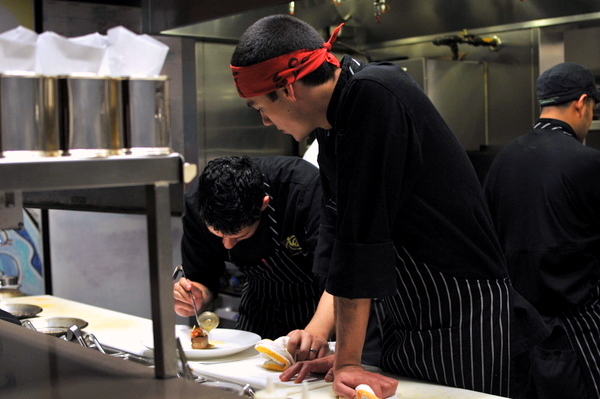



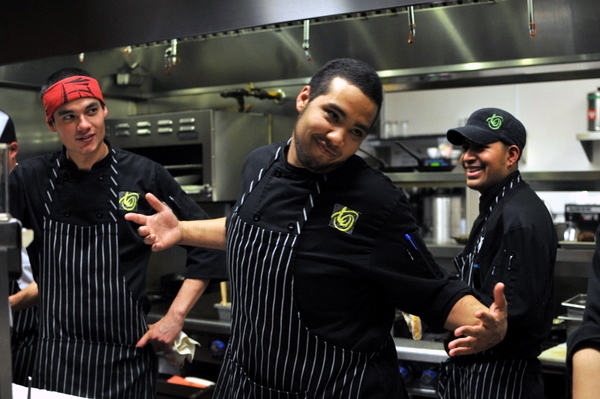
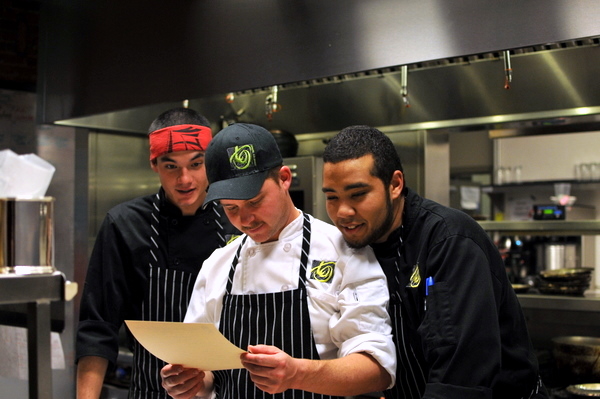
At the end of the night I was bursting full, and though the chefs were impressed with my 12 course menu, they mentioned the record was 16. The omakase is a fun way to sample what TAG has to offer though it feels extremely overpriced with course costing $12.50 (even the petit fours). At the time I didn't realize just how badly they were gouging me, but the fact that I could have ordered full portions of the three on-menu items (sliders, taco sushi, and hiramasa) for less than they charged for the omakase left a bad taste in my mouth. Though in all fairness to TAG, I paid the same price for much much less at Opus less than two weeks before. Price aside, I was very impressed with TAG, yes there were a few uninspired courses, but the spontaneous parts of the omakase showed a level of creativity and talent that made this one of my better experiences in Denver.
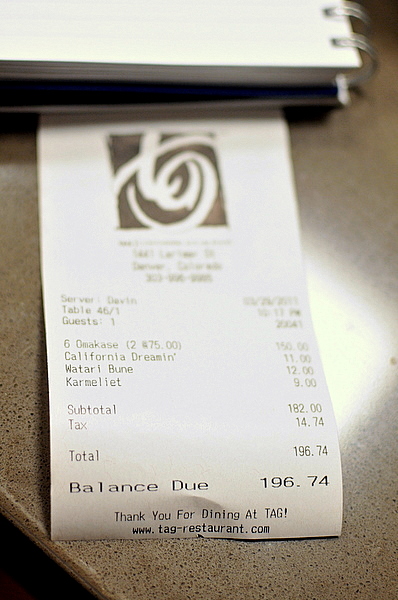
Read more.
























